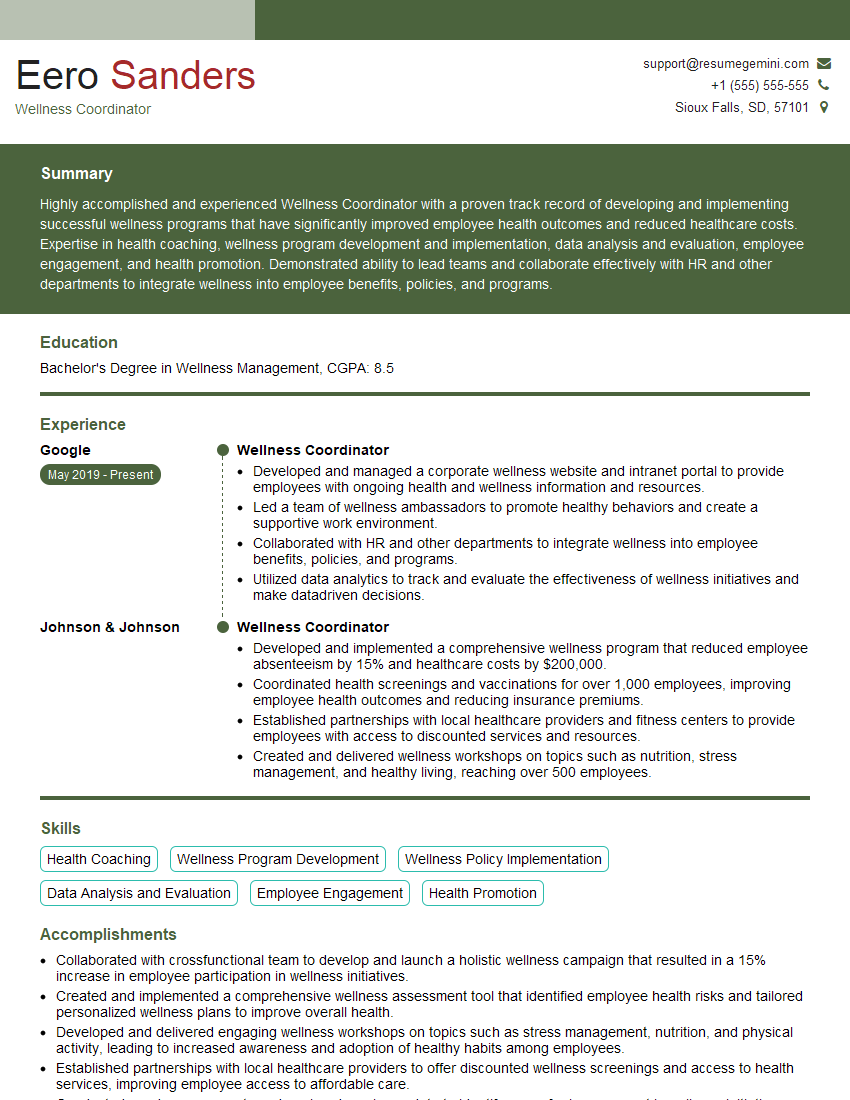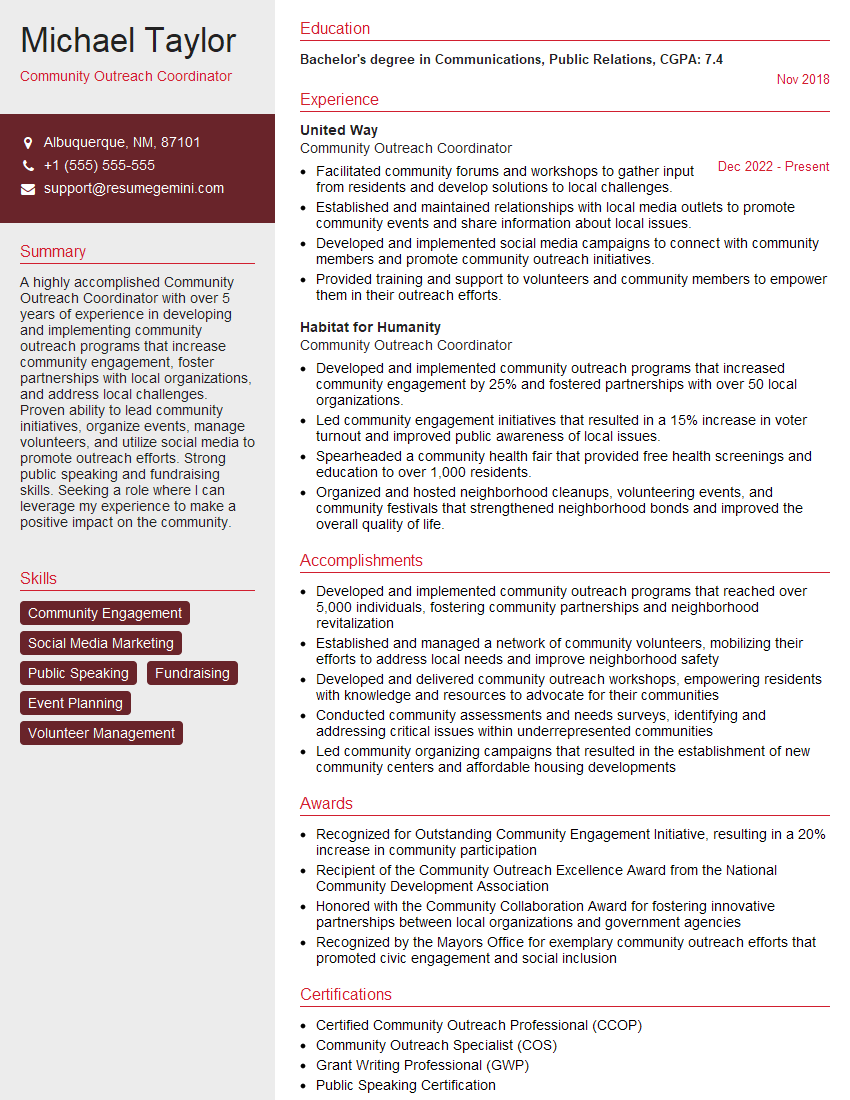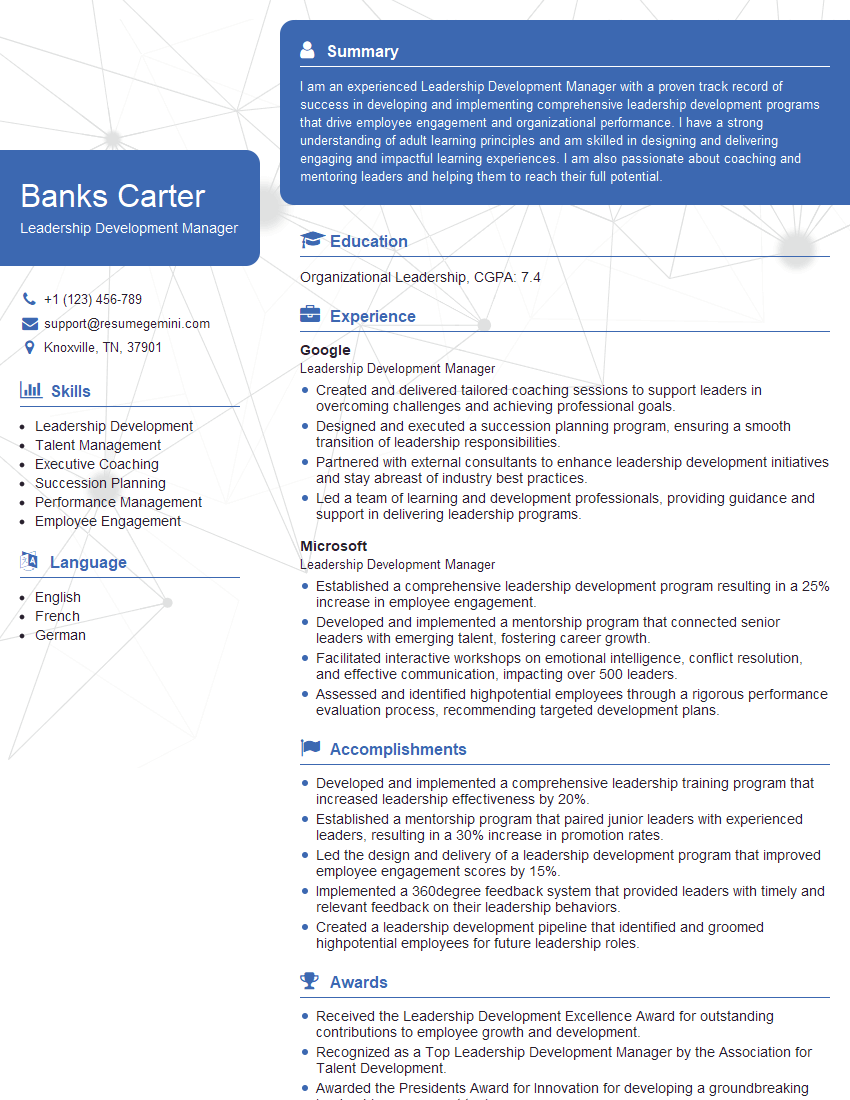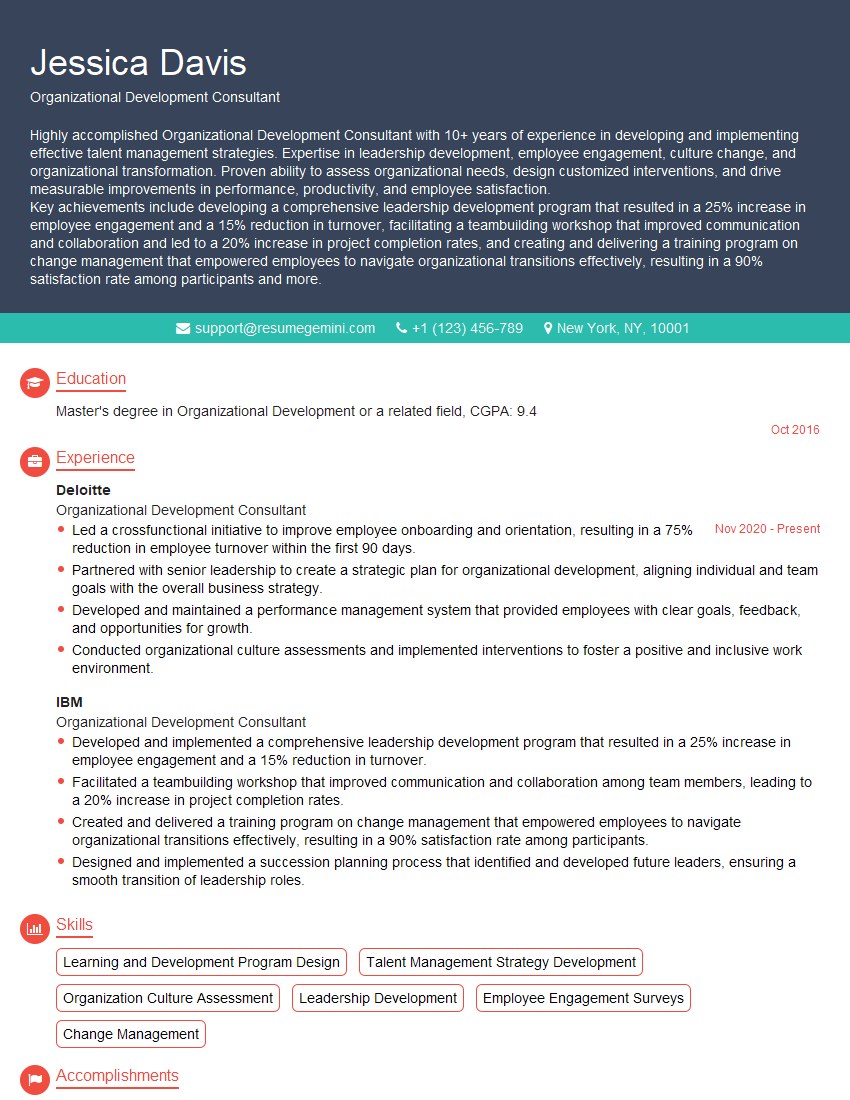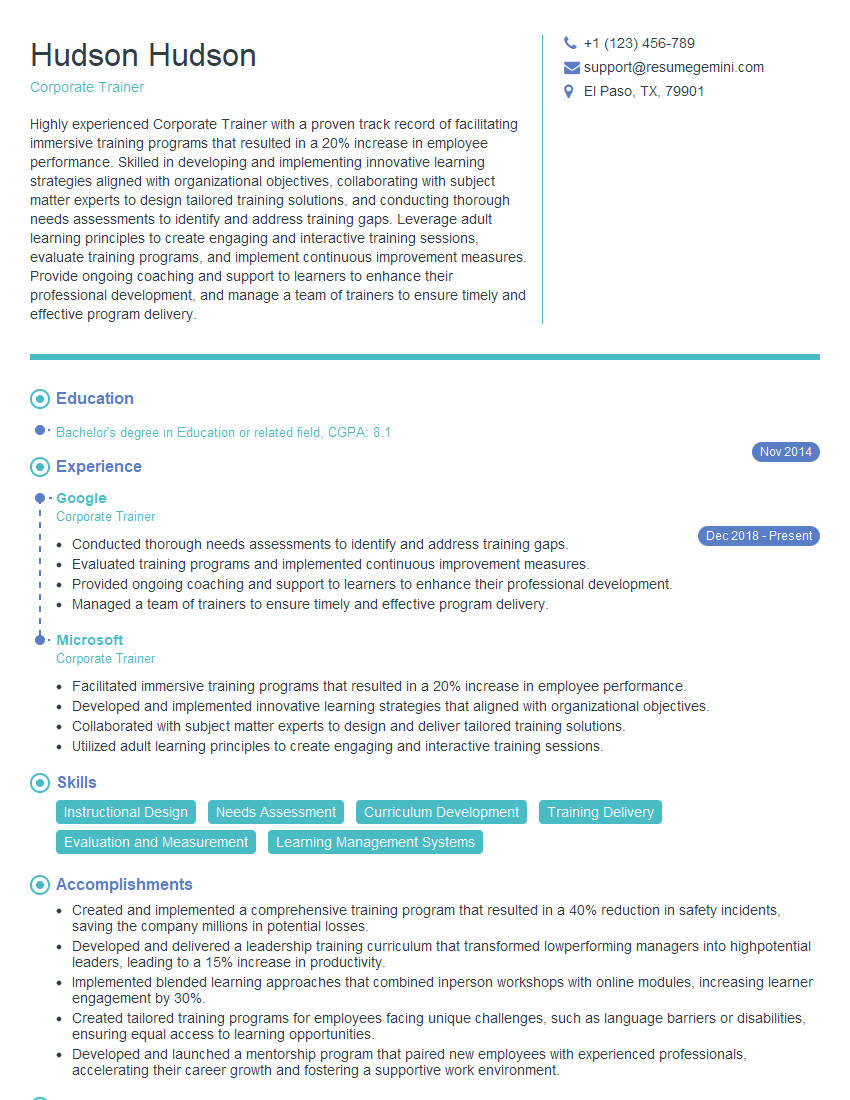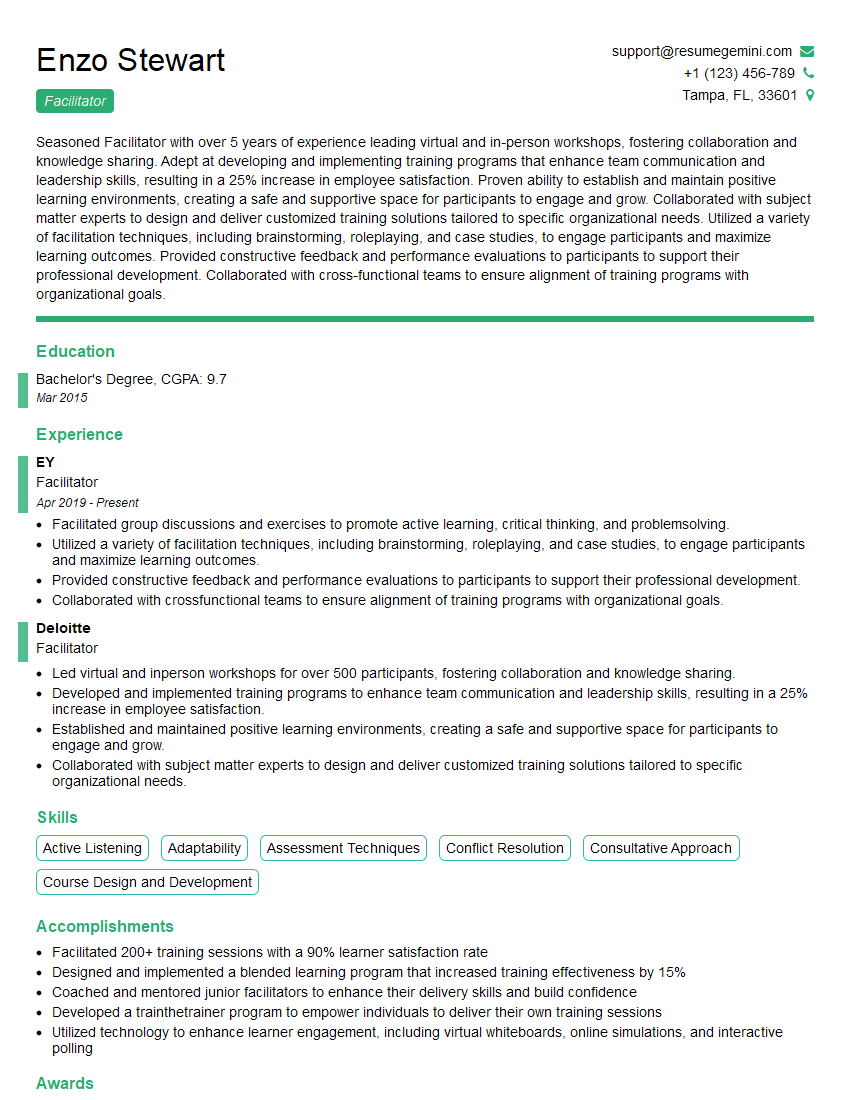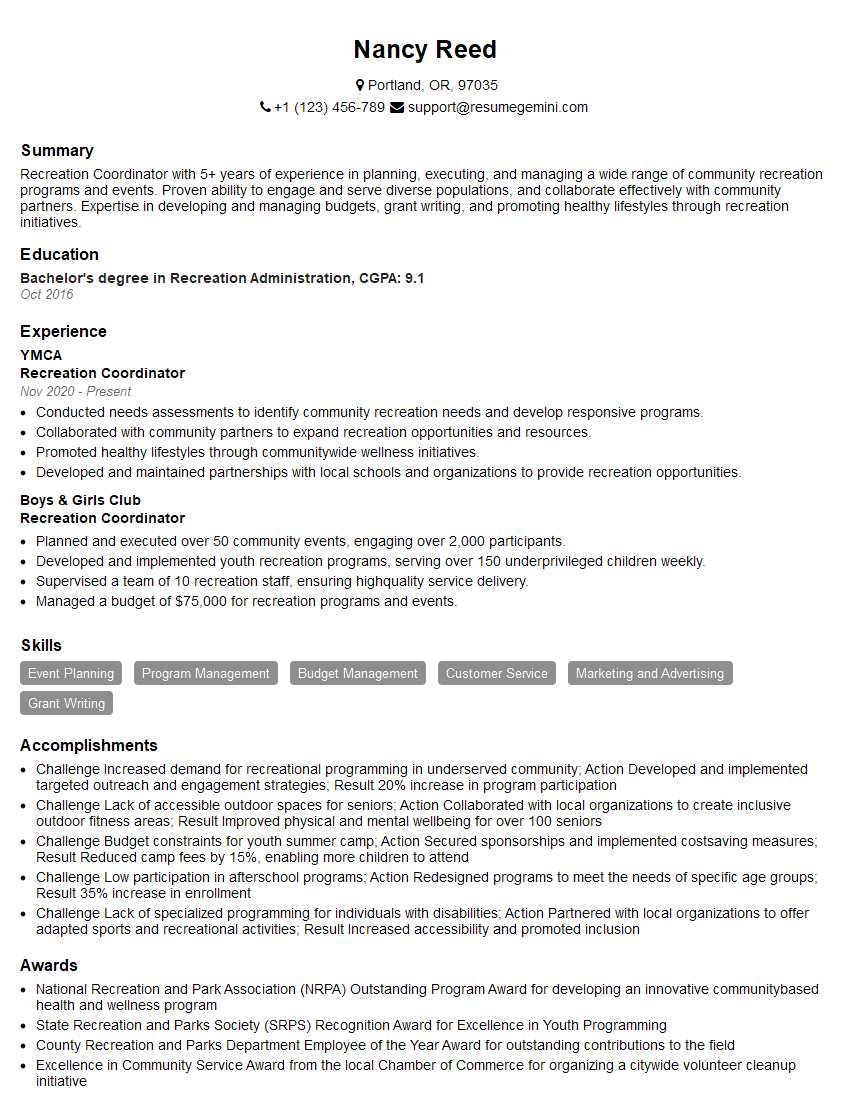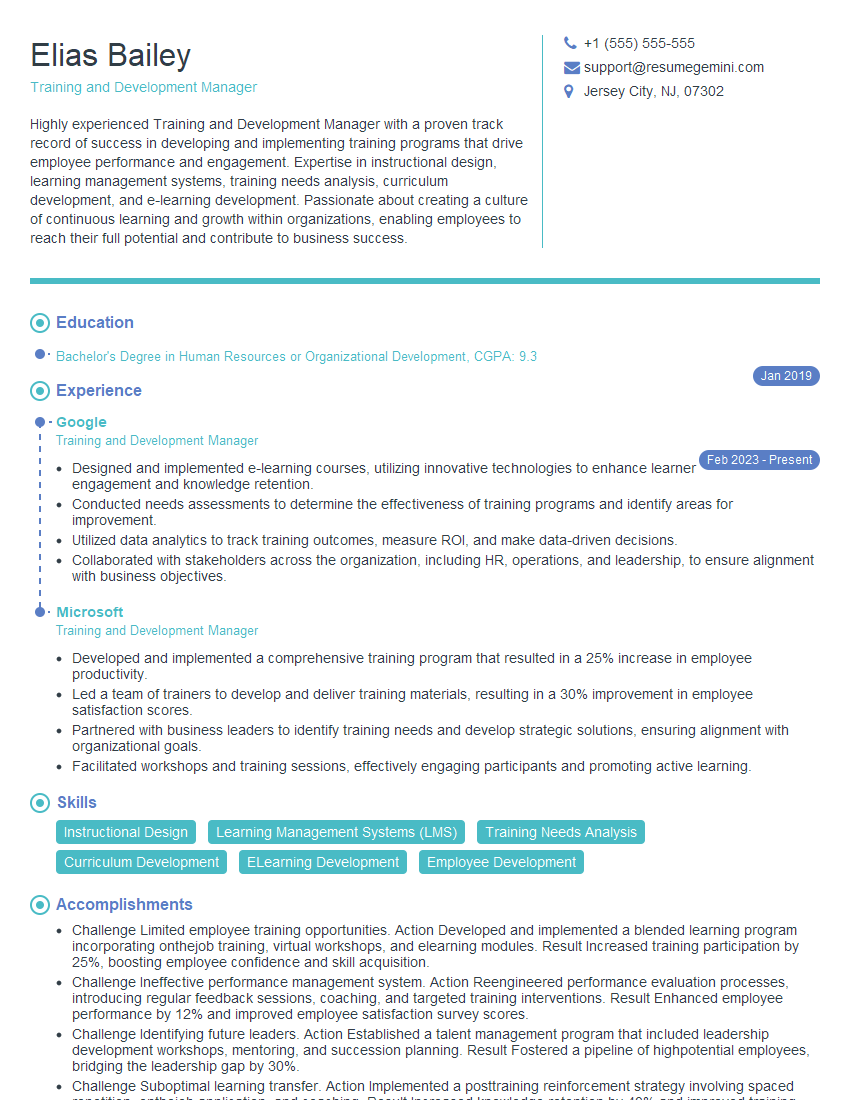Are you ready to stand out in your next interview? Understanding and preparing for Team Building Activities and Initiatives interview questions is a game-changer. In this blog, we’ve compiled key questions and expert advice to help you showcase your skills with confidence and precision. Let’s get started on your journey to acing the interview.
Questions Asked in Team Building Activities and Initiatives Interview
Q 1. What are the five stages of Tuckman’s stages of group development?
Tuckman’s stages of group development is a widely recognized model describing the phases teams go through as they mature. Understanding these stages helps leaders anticipate challenges and facilitate smoother team progression.
- Forming: This initial stage is characterized by dependence and uncertainty. Team members are getting to know each other, defining roles, and establishing ground rules. There’s often politeness and a lack of clear direction. Think of it like the first day of school – everyone’s a bit hesitant and unsure.
- Storming: Conflicts and disagreements arise in this phase as team members assert their personalities and opinions. Power struggles may emerge, and there can be resistance to the leader’s authority. Imagine a brainstorming session where everyone wants their idea to win.
- Norming: The team begins to resolve conflicts and establish norms and working styles. Trust and cohesion start to develop, and members learn to collaborate more effectively. It’s like the team finds its rhythm, agreeing on processes and communication.
- Performing: This is the high-performing stage where the team works efficiently and effectively towards common goals. Members are highly motivated, interdependent, and capable of self-management. They’re like a well-oiled machine, achieving amazing results.
- Adjourning: This final stage involves the dissolution of the team, often after the completion of a project. There can be feelings of sadness or accomplishment, depending on the team’s experience. Think of graduating from a project or completing a major task together.
Q 2. Describe three different team building activities suitable for a remote team.
Remote team building requires creativity and utilizes technology to foster connection and collaboration. Here are three effective activities:
- Virtual Escape Room: Many online platforms offer escape rooms designed for virtual teams. These activities require problem-solving, communication, and collaboration to complete tasks and ‘escape’ within a time limit. It’s a fun and engaging way to build teamwork and improve communication skills.
- Online Team Trivia or Quiz: A simple yet effective way to build camaraderie. Choose a theme relevant to your team or company, and use platforms like Kahoot! or Google Forms to create an interactive quiz. It’s a lighthearted way to learn about each other’s interests and strengths.
- Virtual Coffee Break/Social Hour: Dedicate time for informal online interactions. Use video conferencing to allow for casual conversation. This fosters connections beyond work and allows for relationship building amongst team members. It’s as simple as scheduling a virtual ‘watercooler’ moment.
Q 3. How would you measure the success of a team-building initiative?
Measuring the success of a team-building initiative requires a multi-faceted approach. Don’t just rely on immediate feedback. You need to look at both qualitative and quantitative data:
- Pre and Post-Initiative Surveys: Measure team cohesion, communication effectiveness, morale, and collaboration before and after the activity. This provides data to assess changes.
- Observation and Feedback: Observe team dynamics during projects following the initiative. Note improvements in communication, problem-solving, and overall team performance.
- Team Performance Metrics: Track key performance indicators (KPIs) relevant to the team’s goals to see if there’s a demonstrable improvement in efficiency or productivity.
- Qualitative Feedback: Gather feedback through focus groups or individual interviews to understand team members’ perceptions of the initiative’s impact on their relationships and working style.
By combining these methods, you gain a comprehensive understanding of the initiative’s success.
Q 4. What are some common challenges in implementing team-building activities, and how can they be overcome?
Implementing team-building activities presents several challenges:
- Lack of Time and Resources: Finding time and budget for activities can be difficult, especially in busy work environments. Solution: Prioritize, choose shorter activities, and leverage free or low-cost resources.
- Resistance from Team Members: Some may view team building as a waste of time or feel awkward participating. Solution: Explain the purpose clearly, involve team members in planning, and offer a variety of activities to cater to different preferences.
- Poorly Designed Activities: Activities that are not relevant to the team’s needs or are poorly facilitated can be ineffective. Solution: Choose activities carefully, considering team dynamics and goals, and ensure you have a skilled facilitator.
- Difficulty Measuring Impact: Determining the ROI of team building can be challenging. Solution: Use a combination of qualitative and quantitative methods to measure changes in team performance and morale.
Q 5. Explain the difference between team building and team development.
While related, team building and team development are distinct concepts:
- Team Building: Focuses on improving relationships and communication within a team through activities designed to enhance interpersonal dynamics. It’s about building rapport and trust. Think of it as the ‘social glue’ that holds the team together.
- Team Development: Is a broader, more strategic process focused on improving the team’s overall performance and effectiveness. It involves addressing skills gaps, clarifying roles, and establishing clear goals and processes. This is about making the team more productive and efficient.
Team building can be *part* of team development, but team development encompasses a much wider range of interventions.
Q 6. What are some effective strategies for fostering collaboration within a team?
Fostering collaboration involves creating an environment where team members feel comfortable sharing ideas, supporting each other, and working towards shared goals. Strategies include:
- Establish Clear Goals and Roles: Ensure everyone understands the team’s objectives and individual responsibilities. This reduces ambiguity and promotes a sense of shared purpose.
- Encourage Open Communication: Foster a culture of open dialogue and feedback. This can involve regular team meetings, brainstorming sessions, and informal communication channels.
- Promote Mutual Respect and Trust: Create a safe and inclusive environment where team members feel valued and respected. This allows for honest discussions and constructive criticism.
- Utilize Collaborative Tools: Leverage technologies like project management software, shared documents, and communication platforms to facilitate teamwork and information sharing.
- Celebrate Successes: Acknowledge and reward team accomplishments to reinforce positive behavior and build morale.
Q 7. How do you adapt team-building activities to different team sizes and personalities?
Adapting team-building activities to different team sizes and personalities is crucial for success:
- Team Size: Larger teams might benefit from activities that break into smaller groups to encourage participation and interaction. Smaller teams might prefer activities requiring more individual contributions.
- Personalities: Consider the team’s personality types (e.g., introverted vs. extroverted). Introverted members might be more comfortable with activities that don’t require extensive public speaking, while extroverted members might thrive in collaborative, group-focused activities. Offer a mix to accommodate different preferences.
- Activity Selection: Choose activities that align with the team’s interests and skill sets. Involve the team in selecting activities to increase engagement and ownership.
- Flexibility and Adaptability: Be prepared to adjust the activity or its structure based on the team’s response and engagement levels.
Pre-activity surveys or informal discussions can help gauge the team’s preferences and tailor the experience for optimal impact.
Q 8. Describe your experience designing and facilitating team-building workshops.
Designing and facilitating team-building workshops involves a multi-stage process, starting with a thorough needs assessment. I begin by understanding the team’s specific challenges, goals, and existing dynamics. This might involve interviews with team members, discussions with managers, and analysis of team performance data. Once I have a clear understanding of the needs, I design a workshop tailored to address them. This includes selecting appropriate activities, considering the team’s size and composition, and choosing a suitable venue and timeframe.
For example, for a team struggling with communication, I might incorporate activities like a collaborative storytelling exercise or a problem-solving challenge that requires effective communication. For a team lacking in creativity, I might design a brainstorming session using techniques like mind mapping or SCAMPER.
During the workshop facilitation, my focus is on creating a safe and inclusive environment where participants feel comfortable taking risks and sharing their ideas. I use active listening and observation to gauge the team’s engagement and address any challenges that may arise. Post-workshop, I often conduct a follow-up evaluation to assess the impact of the workshop and identify areas for improvement in future sessions. This iterative process of assessment, design, facilitation, and evaluation ensures that the workshops are effective and relevant.
Q 9. What are some key indicators of a high-performing team?
High-performing teams exhibit several key characteristics. One crucial indicator is clear communication: team members communicate openly, honestly, and respectfully, ensuring everyone is informed and understands their roles. Another key indicator is shared goals and objectives; everyone is aligned on the team’s mission and understands how their individual contributions contribute to the larger goals.
Strong collaboration and trust are also essential. Team members work effectively together, supporting each other and trusting each other’s abilities. Furthermore, high-performing teams demonstrate effective conflict resolution; they address disagreements constructively and find solutions that benefit the entire team. Finally, they show accountability and ownership, where each member takes responsibility for their tasks and contributions.
Q 10. How would you handle conflict within a team during a team-building activity?
Conflict is inevitable, even in well-functioning teams. My approach to handling conflict during a team-building activity involves a few key steps. Firstly, I create a safe space for open discussion, emphasizing respectful communication and active listening. I would encourage the individuals involved to express their perspectives without interruption, focusing on understanding the root causes of the conflict rather than assigning blame.
Secondly, I would facilitate a collaborative problem-solving process. This might involve brainstorming solutions together, identifying common ground, and compromising to reach a mutually agreeable outcome. Throughout the process, I ensure that all voices are heard and that the resolution is fair and equitable for all involved. Finally, I would reinforce the importance of teamwork and mutual respect, emphasizing that disagreements are an opportunity for growth and learning. If the conflict escalates beyond my ability to manage it, I would involve the appropriate management personnel.
Q 11. What are the benefits of using outdoor team-building activities?
Outdoor team-building activities offer several advantages over indoor activities. The change of scenery can promote creativity and encourage a more relaxed and informal atmosphere. Being outdoors often encourages physical activity, which can boost morale, improve team cohesion, and reduce stress.
Outdoor activities often require collaboration and problem-solving in a more immersive way. For instance, activities like ropes courses or orienteering demand teamwork and communication to overcome challenges. The sense of accomplishment from completing a physically and mentally demanding activity can significantly enhance team bonding. Furthermore, the natural environment can provide a calming and rejuvenating experience, reducing workplace stress and improving overall well-being.
Q 12. What are some low-cost, high-impact team-building activities you can implement?
Low-cost, high-impact team-building activities are readily available. A simple and effective activity is a team storytelling exercise, where each member contributes a sentence or paragraph to build a collaborative story. This fosters creativity, communication, and collaboration.
Another option is a problem-solving challenge using readily available materials like LEGOs or office supplies. This encourages creative thinking and problem-solving skills. Volunteer work, such as cleaning a local park or helping at a charity event, can build camaraderie and a sense of purpose. Finally, a simple team lunch or potluck can foster informal interaction and strengthen social bonds within the team.
Q 13. How do you ensure inclusivity and accessibility in team-building activities?
Inclusivity and accessibility are paramount in team-building activities. I start by considering the diverse needs and abilities of all team members. This involves pre-activity questionnaires to identify any physical limitations, learning differences, or cultural sensitivities.
When choosing activities, I prioritize those that are adaptable and inclusive. For example, I would avoid activities that exclude individuals with physical limitations or require specific skills or levels of fitness. I would also adapt instructions and activities to accommodate diverse learning styles and cultural backgrounds. Clear and accessible communication is key; I would ensure all instructions are communicated clearly and that appropriate assistive technologies are available if needed. Furthermore, creating a safe and respectful environment where everyone feels comfortable participating is crucial for fostering inclusivity.
Q 14. Describe a time when a team-building initiative you implemented failed. What did you learn?
In one instance, I designed a highly competitive team-building activity involving a complex, time-sensitive puzzle. While the intention was to encourage collaboration and problem-solving, the intense competition fostered resentment and division within the team. Some members felt overwhelmed and others felt pressured to perform, leading to stress and decreased engagement.
The key learning from this experience was the importance of balancing challenge with collaboration and fostering a supportive rather than competitive environment. I realized that the focus should be on the process of teamwork and mutual support, rather than solely on achieving a specific outcome. In subsequent workshops, I focused on activities that emphasized collaboration and mutual support, prioritizing positive interaction and team bonding over competition.
Q 15. How do you assess the learning outcomes of a team-building activity?
Assessing the learning outcomes of a team-building activity requires a multi-faceted approach. It’s not just about having fun; it’s about measuring whether the activity achieved its intended goals, like improved communication, trust, or problem-solving skills. I typically use a combination of methods:
Pre- and Post-Activity Surveys: These questionnaires gauge participants’ perceptions and skills before and after the activity. Questions might focus on teamwork, communication effectiveness, and confidence levels. Changes in scores indicate learning.
Observations During the Activity: Direct observation allows me to assess how teams collaborate, communicate, and handle challenges. I look for specific behaviors, such as active listening, constructive feedback, and shared leadership.
Debriefing Sessions: A structured discussion after the activity allows participants to reflect on their experiences, identify key learnings, and articulate how they plan to apply these learnings to their work. This is crucial for translating activity insights into real-world application.
Follow-up Assessments: To measure lasting impact, I might conduct follow-up surveys or observations several weeks after the activity to assess whether learned behaviors have been integrated into daily work routines.
Performance Metrics: For activities directly related to workplace projects, improvements in project timelines, quality, or team efficiency can serve as measurable outcomes.
For example, in a recent problem-solving activity, pre-activity surveys revealed low confidence in collaborative problem-solving. Post-activity surveys showed a significant increase in confidence, corroborated by observed improvements in teamwork and communication during the activity and subsequent project success.
Career Expert Tips:
- Ace those interviews! Prepare effectively by reviewing the Top 50 Most Common Interview Questions on ResumeGemini.
- Navigate your job search with confidence! Explore a wide range of Career Tips on ResumeGemini. Learn about common challenges and recommendations to overcome them.
- Craft the perfect resume! Master the Art of Resume Writing with ResumeGemini’s guide. Showcase your unique qualifications and achievements effectively.
- Don’t miss out on holiday savings! Build your dream resume with ResumeGemini’s ATS optimized templates.
Q 16. What are some examples of effective icebreaker activities?
Effective icebreaker activities are crucial for setting a positive and inclusive tone at the start of any team-building event. They should be engaging, easy to participate in, and help people quickly connect with one another. Here are a few examples:
Two Truths and a Lie: Each person shares three statements about themselves – two true and one false. Others guess the lie. This encourages interaction and helps people learn interesting facts about their colleagues.
Human Bingo: Create bingo cards with prompts like “Has traveled to another continent,” “Plays a musical instrument,” or “Loves spicy food.” Participants mingle to find colleagues who match the prompts and get their squares signed. This promotes mingling and discovery of shared interests.
Team Trivia: A light-hearted trivia game tailored to the team’s interests or industry can generate friendly competition and conversation.
Quick Round Robin: Have each participant answer a simple question in quick succession, like “What’s your favorite hobby?” or “What’s one thing you’re looking forward to this week?”
The key is to choose an icebreaker that fits the group’s size, the time available, and the overall tone you’re aiming for. Avoid anything too competitive or potentially embarrassing.
Q 17. How do you build trust and rapport within a team?
Building trust and rapport is the foundation of effective teamwork. It takes time and consistent effort. Here’s a multi-pronged approach:
Vulnerability and Sharing: Encourage team members to share personal anecdotes, work experiences, or challenges. Creating a safe space for open and honest communication is essential. This can be facilitated through structured activities or informal conversations.
Active Listening and Empathy: Train the team in active listening skills— truly hearing and understanding each other’s perspectives. Empathy exercises, such as role-playing different viewpoints, can be incredibly valuable.
Shared Successes and Challenges: Celebrate collective achievements and openly discuss challenges as a team. Working through difficult situations together builds resilience and trust.
Team-Building Activities Focused on Trust: Activities like blindfolded trust walks or complex problem-solving exercises where team members rely on each other create tangible experiences of trust.
Recognition and Appreciation: Regularly acknowledge individual and team contributions, both big and small. This demonstrates respect and fosters a positive work environment.
For example, in one team I worked with, we implemented a weekly “Kudos” session where team members shared positive feedback about each other’s contributions. This simple practice significantly improved team morale and strengthened bonds.
Q 18. What are some techniques for improving communication within a team?
Improving team communication involves fostering clear, consistent, and respectful interactions. Here are some techniques:
Establish Clear Communication Channels: Define preferred methods for different types of communication (e.g., email for formal updates, instant messaging for quick questions, regular meetings for in-depth discussions).
Active Listening Training: Provide training on active listening techniques, including paying attention, asking clarifying questions, and summarizing to ensure understanding.
Nonviolent Communication (NVC): Introduce principles of NVC to help team members express their needs and concerns constructively, avoiding blame and judgment.
Feedback Mechanisms: Implement regular feedback mechanisms, both upward and downward, to encourage open dialogue and address concerns promptly. 360-degree feedback can provide valuable insights.
Utilize Visual Communication Tools: Employ tools like Kanban boards, project management software, or shared documents to enhance transparency and visibility into project progress and tasks.
Regular Team Meetings: Conduct regular team meetings, with clear agendas and defined outcomes, to facilitate information sharing, problem-solving, and relationship building.
In a past project, we introduced daily stand-up meetings with a focus on progress updates, roadblocks, and next steps. This simple change dramatically improved communication flow and project efficiency.
Q 19. How do you use technology to support team-building activities?
Technology plays a significant role in supporting team-building activities, both in-person and remotely. Here are some examples:
Virtual Team Building Platforms: Platforms like Kahoot!, Quizizz, or Gather.town offer engaging virtual team-building games and activities that can be easily accessed by remote teams.
Project Management Software: Tools like Asana, Trello, or Monday.com facilitate collaboration on projects, improving communication and task management, which are integral to effective teamwork.
Video Conferencing: Video conferencing tools like Zoom or Microsoft Teams are crucial for virtual team meetings, allowing face-to-face interaction and fostering stronger relationships.
Collaboration Tools: Google Workspace, Microsoft 365, and other collaborative platforms enable real-time document editing, communication, and shared workspaces, improving team coordination and efficiency.
Online Survey Tools: Tools like SurveyMonkey or Google Forms allow for efficient collection of pre- and post-activity feedback, enabling data-driven evaluation of team-building initiatives.
For instance, in a recent remote team-building event, we used Gather.town to create a virtual space where team members could interact informally, participate in virtual games, and build relationships in a more engaging way than typical video conferencing.
Q 20. How do you ensure that team-building activities align with organizational goals?
Aligning team-building activities with organizational goals is crucial for maximizing their impact. It’s not enough to simply have fun; the activities should contribute to the company’s strategic objectives. Here’s how to achieve this alignment:
Identify Key Organizational Goals: Start by clearly defining the organization’s strategic goals, whether they relate to innovation, efficiency, customer satisfaction, or employee engagement.
Assess Team Needs: Analyze the team’s strengths and weaknesses in relation to those goals. Identify skill gaps or areas where improved collaboration is needed.
Design Activities to Address Needs: Develop team-building activities that directly address identified skill gaps and contribute to organizational goals. For example, if a key goal is improved innovation, the activity could focus on brainstorming and creative problem-solving.
Measure Impact on Goals: Use appropriate metrics to assess the extent to which the team-building activities contributed to the achievement of organizational goals. This could include increased productivity, improved customer satisfaction scores, or more successful project outcomes.
Integrate Learning into Work: Encourage teams to apply the skills and insights gained during the team-building activities to their daily work. This ensures that the learning translates into tangible results.
For example, if the organization aims to improve cross-functional collaboration, a team-building activity might involve a simulated project requiring collaboration across different departments, allowing participants to practice those skills in a safe environment.
Q 21. Describe your experience using different team-building assessment tools.
I’ve used various assessment tools to evaluate team dynamics and the effectiveness of team-building initiatives. My experience encompasses both qualitative and quantitative methods:
Team Effectiveness Surveys: These questionnaires, often using Likert scales, measure team cohesion, communication effectiveness, and overall performance. Examples include the Group Environment Questionnaire (GEQ) and the Team Climate Inventory (TCI). These provide valuable quantitative data about team functioning.
360-Degree Feedback: This method involves collecting feedback from team members, supervisors, and other stakeholders to provide a comprehensive view of an individual’s performance within the team. This provides a multi-perspective assessment of behaviors and contributions.
Observation Protocols: I’ve developed and used observation protocols to systematically record team behaviors during activities, focusing on aspects like communication patterns, conflict resolution styles, and leadership emergence. This offers a qualitative understanding of team interactions.
Personality Assessments (e.g., Myers-Briggs Type Indicator): While not directly a team assessment tool, understanding individual personality preferences can be insightful in designing appropriate team-building activities and explaining team dynamics.
The choice of assessment tool depends on the specific context and the goals of the assessment. Often, a combination of methods provides the most comprehensive and insightful evaluation. For example, in one case, we used a combination of pre- and post-activity team effectiveness surveys and observation protocols to gauge the impact of a leadership development workshop on team performance.
Q 22. How do you create a safe and inclusive environment for team building activities?
Creating a safe and inclusive environment for team building is paramount. It’s about fostering a sense of psychological safety where everyone feels comfortable participating, regardless of their background, personality, or skill level. This starts with pre-activity communication. Clearly outlining the goals and activities, emphasizing participation is voluntary, and highlighting the importance of respect and inclusivity sets the tone.
- Pre-activity communication: Use inclusive language in invitations and descriptions. Specify any physical requirements and offer alternatives where appropriate. Emphasize that the goal is to learn and connect, not to compete harshly.
- Activity Selection: Choose activities that cater to diverse abilities and preferences. Avoid activities that could inadvertently exclude or marginalize participants. For example, instead of a physically demanding sport, consider a collaborative puzzle-solving exercise or a creative project.
- Facilitator Role: A skilled facilitator actively monitors group dynamics, addresses any concerns immediately, and ensures everyone feels heard and valued. They actively model inclusive behavior and intervene subtly if someone is being excluded or made uncomfortable.
- Ground Rules: Establish clear ground rules emphasizing respect, active listening, and constructive feedback. This could include things like “no interrupting,” “everyone gets a chance to speak,” and “confidentiality of shared thoughts and feelings.”
- Post-activity debrief: A structured debrief allows for feedback and reflection. This is an opportunity to check in with team members, address any concerns that arose during the activity, and celebrate successes.
For example, if a team is diverse in terms of physical abilities, a team-building activity like a scavenger hunt could be adapted to include options for participants with different mobility levels. Some clues could be solved using technology, while others might involve physical tasks with varying degrees of difficulty.
Q 23. What are some common team dynamics issues, and how can you address them?
Common team dynamics issues often stem from poor communication, lack of trust, conflict avoidance, or unclear roles and responsibilities. Addressing these requires a multifaceted approach.
- Poor Communication: This can be tackled through clear communication strategies, active listening exercises, and the use of collaborative tools. For instance, regular team meetings using a structured agenda can help ensure everyone is heard.
- Lack of Trust: Building trust requires vulnerability and open communication. Activities like trust falls (done safely and with consent) or shared storytelling can foster trust. Showing appreciation for individual contributions is also key.
- Conflict Avoidance: A healthy team embraces constructive conflict as an opportunity for growth. Training on conflict resolution techniques and establishing processes for handling disagreements is crucial. A structured approach, such as identifying the root of the conflict, brainstorming solutions together, and agreeing on actions, can be incredibly helpful.
- Unclear Roles and Responsibilities: This often leads to confusion and frustration. Clarifying roles through job descriptions, team charters, or RACI matrices (Responsible, Accountable, Consulted, Informed) provides clarity and accountability.
For example, if a team is experiencing conflict due to unclear responsibilities, facilitating a workshop to clarify individual roles and create a shared responsibility chart can resolve the issue. Similarly, if communication is lacking, implementing a regular team check-in system (using a tool like Slack or Microsoft Teams) can improve communication flow and transparency.
Q 24. How do you evaluate the ROI of a team building initiative?
Evaluating the ROI of a team-building initiative goes beyond simply measuring fun. It’s about assessing its impact on key business outcomes. This requires a multi-pronged approach focusing on qualitative and quantitative data.
- Define Measurable Objectives: Before the activity, define specific, measurable, achievable, relevant, and time-bound (SMART) goals. These might include improved team cohesion, increased communication effectiveness, or enhanced problem-solving skills.
- Pre and Post-Activity Assessments: Use surveys, questionnaires, or focus groups to measure team dynamics before and after the activity. This helps gauge improvements in areas like communication, trust, and collaboration.
- Observe Behavioral Changes: Monitor team performance in the weeks following the activity. Are there improvements in productivity, project completion rates, or conflict resolution? This could be tracked through project management tools or performance reviews.
- Qualitative Feedback: Gather qualitative feedback through individual interviews or team discussions. This provides valuable insights into participants’ experiences and the impact of the activity on their perspectives.
- Cost-Benefit Analysis: Calculate the total cost of the team-building initiative (including time, materials, and facilitator fees) and compare it to the benefits achieved (e.g., improved productivity leading to increased revenue, reduced conflict leading to lower costs).
For instance, if the goal was to improve problem-solving skills, you could compare the team’s performance on a specific project before and after the team-building activity, measuring metrics like time to completion and quality of the solution. The improvement can then be linked to a potential financial benefit.
Q 25. What are some best practices for post-activity follow-up?
Post-activity follow-up is crucial for reinforcing learning and translating the experience into sustained positive change within the team.
- Share Key Takeaways: Summarize the main learning points and insights from the activity and share them with the team. This could be done through an email, presentation, or informal meeting.
- Action Planning: Facilitate a discussion on how to apply the skills and insights learned during the activity to daily work. Collaboratively develop an action plan with specific tasks and responsibilities.
- Continuous Reinforcement: Reinforce positive behaviors and communication styles observed during the activity. Recognize and reward team members for demonstrating improved collaboration or problem-solving skills.
- Seek Ongoing Feedback: Check in with the team regularly to assess how they are applying the learned skills and to address any challenges they may be facing. This could be done through informal check-ins or brief surveys.
- Document Successes: Keep a record of the positive outcomes resulting from the team-building activity and use this as evidence to support future investments in team development initiatives.
For example, after a team-building activity focused on communication, you might send a follow-up email summarizing key communication strategies discussed, and suggest team members actively use these strategies in their daily interactions. You could also schedule a follow-up meeting a month later to check on progress and address any challenges.
Q 26. How would you handle a team member who is resistant to participating in team-building activities?
Handling resistance to team-building activities requires a sensitive and empathetic approach. The key is understanding the root cause of the resistance.
- Understand the Resistance: Have a private conversation with the resistant team member to understand their concerns. Are they feeling overwhelmed, skeptical, or do they have personal commitments?
- Address Concerns: Actively listen to their concerns and address them honestly and respectfully. Provide reassurance that participation is voluntary, highlight the benefits, and offer alternatives if appropriate.
- Offer Alternatives: If they are uncomfortable with the planned activity, explore alternative ways for them to contribute to team cohesion. Perhaps they could assist with planning a future activity or take on a leadership role in a smaller group project.
- Emphasize Individual Benefits: Focus on the personal development and growth opportunities that team building offers. Highlight how improved communication and collaboration skills can benefit their career development.
- Make it Optional (But Encouraged): Clearly communicate that participation is not mandatory. However, emphasize the benefits of engagement and create an inclusive environment where they feel welcome to participate even if only partially.
For example, if a team member is hesitant due to time constraints, offer them the option to participate in a shorter, more focused activity or to contribute remotely. If they express skepticism about the value of team building, explain how it directly relates to improved team performance and individual growth.
Q 27. What are your preferred methods for gathering feedback on team-building activities?
Gathering feedback is crucial for continuous improvement. I utilize a mix of methods to capture diverse perspectives.
- Post-Activity Surveys: Anonymous online surveys are a great way to collect quantitative data on participants’ satisfaction, learning outcomes, and suggestions for improvement. Keep the survey concise and focused.
- Focus Groups: Small group discussions facilitated by a neutral party can provide rich qualitative insights into participants’ experiences and perspectives. This encourages open and honest feedback.
- Individual Interviews: One-on-one interviews can provide deeper insights into individual experiences, particularly for those who may be hesitant to share their opinions in a group setting.
- 360-Degree Feedback: Gather feedback from multiple sources, including team members, managers, and even clients, to get a holistic view of the impact of the activity.
- Observation and Informal Feedback: Observe team dynamics during and after the activity to gather informal feedback. Pay attention to team interactions, communication styles, and overall energy levels.
For example, a post-activity survey could include rating scales for satisfaction, learning, and engagement, along with open-ended questions for feedback and suggestions. The focus group would allow deeper discussion of themes that emerge from the survey data.
Q 28. How do you adapt your approach to team building depending on the organizational culture?
Adapting my approach to different organizational cultures is essential for effective team building. Organizational culture significantly influences how teams interact and what activities will resonate.
- Understand the Culture: Before planning any activity, thoroughly understand the organization’s culture. Is it formal or informal? Is it highly collaborative or more individualistic? What are the company values?
- Align Activities with Values: Choose activities that align with the organization’s values and goals. For example, in a highly competitive environment, a team-building activity that promotes collaboration might not be as effective as one that focuses on achieving shared goals.
- Consider Communication Styles: Adapt the communication style to match the organization’s preference. In a formal organization, structured communication might be preferred, while a more informal environment might benefit from a less structured approach.
- Adjust the Level of Structure: The level of structure in the activity should be tailored to the organization’s culture. A highly structured activity might be appropriate for a formal organization, while a more flexible activity might be better suited for an informal environment.
- Seek Input from Leaders and Employees: Involve organizational leaders and employees in the planning process to ensure buy-in and alignment with the organizational culture. This helps build support for the initiative and increases the likelihood of success.
For example, in a highly collaborative organization, a team-building activity that involves a shared creative project might be very successful. However, in a more hierarchical organization, a more structured activity with clearly defined roles might be more effective. Always consider the context and tailor your approach accordingly.
Key Topics to Learn for Team Building Activities and Initiatives Interview
- Understanding Team Dynamics: Explore different team structures, communication styles, and conflict resolution strategies. Consider the impact of personality types and individual roles within a team.
- Activity Selection & Design: Learn how to choose appropriate team-building activities based on team size, goals, and available resources. Understand the process of designing activities that foster collaboration, communication, and problem-solving.
- Facilitation & Leadership: Develop your skills in guiding and facilitating team-building activities. Practice effective communication, active listening, and providing constructive feedback.
- Measuring Success & Evaluation: Learn to define clear objectives for team-building activities and develop methods to assess their effectiveness. Understand how to gather feedback and measure the impact on team performance.
- Overcoming Challenges: Explore common challenges in team building, such as resistance to participation, personality clashes, and unequal contribution. Develop strategies for addressing these issues proactively.
- Adaptability & Flexibility: Understand the importance of adapting team-building activities to different contexts and situations. Learn how to adjust your approach based on the team’s needs and response.
- Theories of Team Building: Familiarize yourself with established models and frameworks for understanding team dynamics and improving collaboration (e.g., Tuckman’s stages of group development).
- Practical Application in Various Settings: Consider how these principles translate to diverse work environments, from small start-ups to large corporations, and across different industries.
Next Steps
Mastering Team Building Activities and Initiatives significantly enhances your leadership skills and demonstrates your ability to foster collaborative and high-performing teams – valuable assets in any career. To showcase these skills effectively, a strong, ATS-friendly resume is crucial. ResumeGemini offers a powerful tool to create a professional and impactful resume that highlights your relevant experience and expertise. Examples of resumes tailored to Team Building Activities and Initiatives are available to help you get started. Invest the time to craft a compelling resume – it’s your first impression and a key to unlocking exciting career opportunities.
Explore more articles
Users Rating of Our Blogs
Share Your Experience
We value your feedback! Please rate our content and share your thoughts (optional).
What Readers Say About Our Blog
Hello,
We found issues with your domain’s email setup that may be sending your messages to spam or blocking them completely. InboxShield Mini shows you how to fix it in minutes — no tech skills required.
Scan your domain now for details: https://inboxshield-mini.com/
— Adam @ InboxShield Mini
Reply STOP to unsubscribe
Hi, are you owner of interviewgemini.com? What if I told you I could help you find extra time in your schedule, reconnect with leads you didn’t even realize you missed, and bring in more “I want to work with you” conversations, without increasing your ad spend or hiring a full-time employee?
All with a flexible, budget-friendly service that could easily pay for itself. Sounds good?
Would it be nice to jump on a quick 10-minute call so I can show you exactly how we make this work?
Best,
Hapei
Marketing Director
Hey, I know you’re the owner of interviewgemini.com. I’ll be quick.
Fundraising for your business is tough and time-consuming. We make it easier by guaranteeing two private investor meetings each month, for six months. No demos, no pitch events – just direct introductions to active investors matched to your startup.
If youR17;re raising, this could help you build real momentum. Want me to send more info?
Hi, I represent an SEO company that specialises in getting you AI citations and higher rankings on Google. I’d like to offer you a 100% free SEO audit for your website. Would you be interested?
Hi, I represent an SEO company that specialises in getting you AI citations and higher rankings on Google. I’d like to offer you a 100% free SEO audit for your website. Would you be interested?
good

